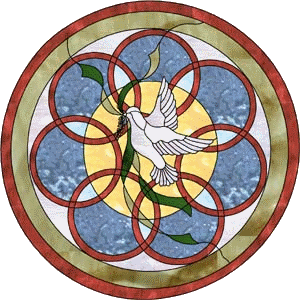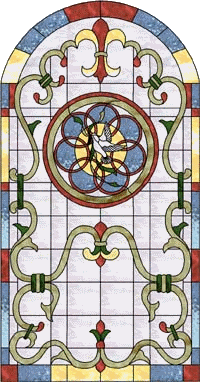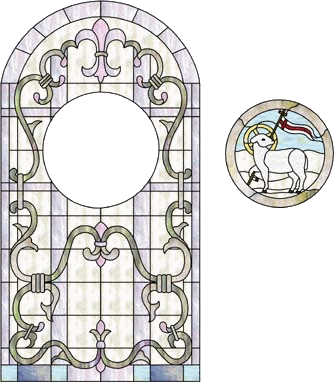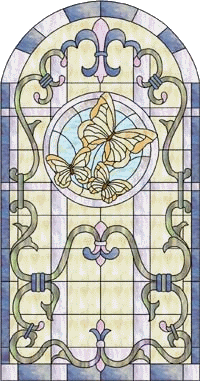Design of the Month · June 2005
-

"Pray for the Peace of the World"
One of the most rewarding projects for any visual artist is working with symbolism to design an artwork series, a picture book of sorts. We tell a story or create a mood using objects from nature or stylized symbols, often combining the two to convey a unique message. Working toward this goal, our composition must satisfy three basic design elements: be pleasing to look at, tell a story and have a deeper spiritual meaning.

Design of the Month
"Pray for the Peace of the World" was first used in 2002 to create a three-thousand piece mosaic, a memorial to all who were touched by the tragedy of September 11. Its design was inspired by the concept of the mandala. By using objects from nature, symbols and the colors of the church year, my goal was to tell a story of prayer and healing. The deeper spiritual message is open to interpretation.
The real beauty of symbolism is its ability to speak a universal language.
The background I used for this series is my adaptation of an old German window design. It is also filled with symbolism: the informal arch at the top, the subtle cross behind the center medallion, the green stylized vine with buds and the fleur-de-lis. Even the continuity of design between the vine and the fleur-de-lis has a symbolic reference. Although I have given it a more contemporary twist, it remains very true to the old design.
Drawing the old-fashioned way
Before I started working with Glass Eye 2000, I would have spent many hours drawing these designs. The original sketches would have been redrawn, refined and enlarged to full size. After completing a color rendering and artist’s proof on vellum I would draft the cartoon. Each design would have taken about a week to complete. Size, color or design changes required new drawing sets, a very time intensive process.
Designing with Glass Eye 2000
Using Glass Eye 2000, I have been able to create a library of patterns and background styles. They are saved as template files that can be resized, edited and used for multiple projects. To complete the stained glass designs for this series, I started with a background template already in my library and made the necessary design changes using Glass Eye 2000 drawing tools such as circles, arches, and straight lines. The revised drawing was saved and the original artwork was scanned in to complete the background design. (See the image on the left.)

Each medallion (such as the figure to the right) was designed separately and then moved into place. I created three medallions for this series and individually colored each combination of background and medallion. Each medallion was also saved as a separate file to be used for future projects. Glass Eye 2000 makes it possible to archive designs, combine files, and move through a complicated design situation with ease.
Color and texture
Selecting the right colors and glass styles is one of the most important steps in the design process. Your choices determine the mood, the importance of specific design elements, and overall visual impact. I always choose my glass in natural light to see how it is affected by sunlight and shade. Understanding the ever-fluid nature of glass is an essential design skill.
Although there are many of resources available on the subject of colors and textures, taking a common sense approach is a good place to start. Keep things simple and build on a combination of a few colors and textures; then, experiment, experiment, experiment! The Glass Eye 2000 color and glass library is a great tool for this; it’s easy to use and it’s fun.
Telling a story

Although these designs are based solely on Christian symbolism, the same design rules apply to any similar project. Art through the ages is filled with symbolism; consider the paintings of the Old Masters filled with objects that symbolize loyalty, treachery and secret messages, or the romantic Victorian language of flowers, symbols of love and rejection!
Using Glass Eye 2000 these designs were completed in less than a week, a far cry from the time that it would have taken to complete this project the old-fashioned way, the best part… the designs are ready to be used again and again, no matter what the size or color palette.
Very few projects are approved without some type of change. Working with Glass Eye 2000 has saved me countless hours because simple design and color changes can be made quickly and easily. In addition, Glass Eye 2000 calculates a materials list and construction costs as you design — an invaluable tool when working with multiple panels to stay on budget. Did I tell you, I love this program!
~ Sandy McKenney
About the artistSandy McKenney is an award winning multimedia artist with over thirty years of experience in both fine and decorative arts. She has been designing and building stained glass for ten years. She may be contacted at mckenneyartglass@sbcglobal.net.
This pattern may be used to make one or more artworks for sale or personal enjoyment. This pattern may be printed for personal use only and may not be sold or given away in printed or electronic form.
Each month we feature a project designed using Glass Eye 2000. Do you have a project to share with the world? Contact Dragonfly Software and your creation might be our next Design of the Month.